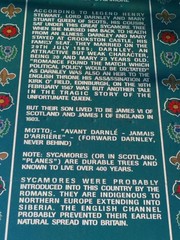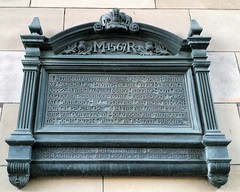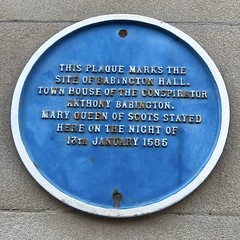Queen Mary Stuart of Scotland


Queen Mary Stuart of Scotland
(1542-1587)
woman, Queen of Scotland (1542-1567), and Queen Consort of France (1559-1560)
Family tree
cousin of Elizabeth I of England 1533-87
Commemorated on 9 plaques
Kings, Queens & Cromwell Saint Margaret, Queen of Scotland Revered wife of King Malcolm III (reigned 1058-93). Canonised in 1250. According to tradition, her relics (skull and hair) were hidden at Rossend Castle from c1565 to c1580 to prevent their destruction at the Reformation. King Alexander III (Reigned 1249-86) Killed in an accident near Kingswood, bringing to an end Scotland's 'Golden Age'. Commemorated by his memorial on the road to Kinghorn. King James V (Reigned 1513-42) Saw the potential of Burntisland harbour and developed it - the catalyst for the town we know today. Granted Royal Burgh status to Burntisland in 1541. Mary, Queen of Scots (Reigned 1542-67) Frequent visitor to Burntisland, staying at Rossend Castle - the scene of her notorious attempted seduction by the French poet, Pierre de Châtelard. King James VI (Reigned 1567-1625) Proposed a new version of the Bible at the General Assembly of the Church of Scotland held at Burntisland in 1601. Confirmed Burntisland's status as a Royal Burgh. King Charles I (Reigned 1625-49) Lost his potentially priceless treasure when his baggage ferry sank off Burntisland in 1633. Oliver Cromwell (Lord Protector of England 1653-58) His forces occupied Burntisland from 1651 to 1660, subjecting the inhabitants to a period of great tyranny and oppression.
Union Street, Burntisland, United Kingdom where they visited (1564-1579)
Clatteringshaws Dam. Constructed by The Galloway Water Power Company 1932-34 Clatteringshaws Dam and the loch occupy ground memorable in Scottish history; close by the dam ran the old Edinburgh road leading to Whithorn (Candida casa IV-V th century). The earliest Christian foundation in Scotland. The waters of the loch are gathered from the fastnesses of the dungeon of Buchan and from the site of that ancient forest of Buchan where Robert Bruce was hard pressed by his enemies after his return to Scotland from Rathlin in 1307. A victory gained near this place by Robert Bruce or his brother Edward is commemorated by the great boulder known as the King's or Bruce's Stone which stands near the shores of the loch 700 yards north of Clatteringshaws Farm. Mary Queen of Scots passed this way on 13th August 1563. The surrounding wilds were sought as a refuge by the covenanters during their struggles in the seventeenth century.
Clatteringshaws Dam, Galloway Forest Park, United Kingdom where they passed through (1563)
Seagate Castle Treaty of Irvine signed in the old castle 9th July 1297. Mary Queen of Scots, with her "four Maries" Mary Beaton, Mary Seaton, Mary Fleming & Mary Livingstone visited the castle, 1st August 1563 and was entertained by Hugh, 3rd Earl of Eglinton, one of her most faithful adherents. "I was the Queen o' bonnie France and I'm the sovereign of Scotland."
Seagate, Ayrshire, KA12 8RE, Irvine, United Kingdom where they visited (1562)
According to legend, Henry Stewart, Lord Darnley and Mary Stuart Queen of Scots, his cousin, sat under this great sycamore tree when she nursed him back to health after an illness. Darnley and Mary stayed at Crookston Castle, his family seat. They married on the 29th July 1565; Darnley, an attractive but weak character, being 20 and Mary 23 years old. "Romance found the match which political policy would be dictated" as Darnley was also a heir to the English throne. His assassination at Kirk O' Field, Edinburgh, on the 10th February 1567 was but another tale in the tragic story of the unfortunate Queen. But their son lived to be James VI of Scotland and James I of England in 1603. Motto: - "Avant Darnlé - jamais d'arrière" - (forward Darnley - never behind). Note: sycamores (or in Scotland, "planes") are durable trees and known to live over 400 years. Sycamores were probably introduced into this country by the Romans. They are indigenous to Northern Europe extending into Siberia. The English Channel probably prevented their earlier natural spread into Britain.
The Darnley plane tree, Nitshill Road (at Kennishead Road junction), Glasgow, United Kingdom where they was
On this site stood the lodgings of Sir Simon Preston of Craigmillar, Provost of the City of Edinburgh 1566-7, in which lodging Mary Queen of Scotland after her surrender to the confederate lords at Carberry Hill, spent her last night in Edinburgh, 15 June 1567. On the following evening she was conveyed to Holyrood and thereafter to Lochleven Castle as a state prisoner.
253 High Street, Edinburgh, United Kingdom where they stayed (1567)
Mary Queen of Scots stayed here 1576 - 1578
The Old Hall Hotel - The Square, Buxton, United Kingdom where they stayed (1575-1577)
The plaque commemorate the landing in Leith of Marie Stuart Queen of Scots upon her return from France on 19th August 1561
Shore, Leith, United Kingdom where they landed (1561)
This plaque marks the site of Babington Hall, townhouse of the conspirator Anthony Babington. Mary Queen of Scots stayed here on the night of 13th January 1585
58 St Peter's Street, Derby, United Kingdom where they stayed (1585)
This plaque commemorates the landing in Leith of Marie Stuart, Queen of Scots, upon her return from France on 19th August 1561. Placed here by the Marie Stuart Society in the year of the Golden Jubilee of Her Majesty Queen Elizabeth 2002.
Shore, Edinburgh, United Kingdom where they was (1560)








